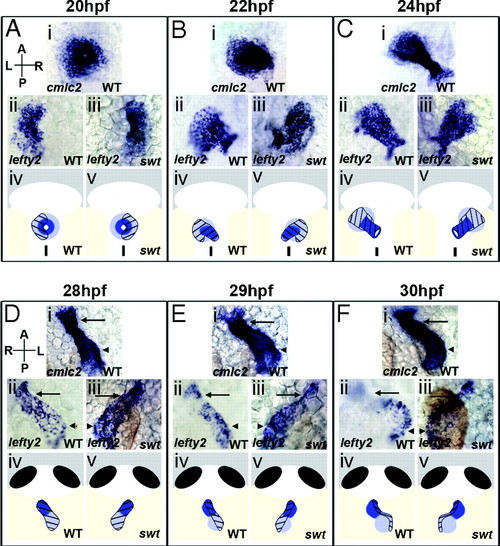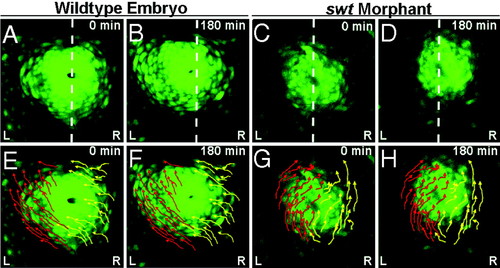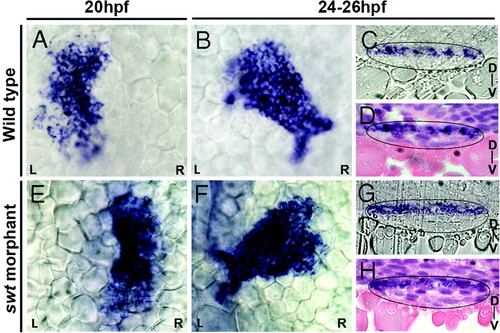- Title
-
Direct and indirect roles for Nodal signaling in two axis conversions during asymmetric morphogenesis of the zebrafish heart
- Authors
- Baker, K., Holtzman, N.G., and Burdine, R.D.
- Source
- Full text @ Proc. Natl. Acad. Sci. USA
|
lefty2 expression temporally correlates with establishment of morphological asymmetries in the heart. Dorsal (A–C) and ventral (D–F) views of the heart from 20–30 hpf. Arrows indicate the ventricle and arrowheads the atrium (Di–Fiii). Cardiac cells were visualized by RNA in situ hybridization for cmlc2, expressed in all myocardial cells, and lefty2. In WT, lefty2 expression is restricted to the left myocardium at 20 hpf (Aii), but extends symmetrically along the length of the left-jogged heart by 22–28 hpf (Bii, Cii, and Dii). A swt morphant exhibits reversed lefty2 expression in the right myocardium (Aiii) at 20 hpf. At 22–28 hpf, lefty2 is expressed along the length of the right-jogged heart in swt morphants (Biii, Ciii, and Diii). At 28–30 hpf, lefty2 expression becomes restricted to the left side of the heart in WT (Eii) and is expressed exclusively along the left margin of the looping heart at 30 hpf (Fii). This process is reversed in swt morphants at 29 hpf. In this embryo, lefty2 expression is still visible across the atrium (Eiii, arrowhead) but it restricted to the right side of the ventricle (Eiii, arrow). Right-sided localization is more pronounced by 30 hpf, with lefty2 expression restricted to the right in both chambers (Fiii). The diagrams show atrial cells (light blue), ventricular cells (dark blue), localization of lefty2 (black hatchmarks). L, left; R, right; A, anterior; P, posterior. EXPRESSION / LABELING:
PHENOTYPE:
|
|
Asymmetric atrial cell migration promotes rotation of the cardiac cone. (A–H) Dorsal views of the heart in Tg(cmlc2:egfp) embryos between 18–21 hpf. (A–D) Dotted white lines indicate the embryonic midline. (E–H) Arrows indicate trajectories of left (red) and right (yellow) cells. A, E, C, and G are the first frames of time lapses (0 min), and B, F, D, and H are the final frames (180 min). A, B, E, and F are frames from a time lapse of a single WT embryo, and C, D, G, and H are frames from a time lapse of a single swt morphant. In WT embryos, the left atrial myocardium migrates asymmetrically along the left of the cone toward the left and anterior (E and F). The right cardiac cells also migrate toward the anterior and left, but rather than sweeping along the lateral edge of the cone, these cells migrate toward the lumen (E and F). In swt morphants the L/R directionality of these cellular trajectories is reversed (C, D, G, and H). L, left; R, right. EXPRESSION / LABELING:
PHENOTYPE:
|
|
Asymmetric cardiac jogging results in a L/R to D/V axis conversion. Shown are dorsal views of lefty2 expression in the heart at 20 hpf and 24–26 hpf (A, B, E, and F) and in transverse histological sections at 24–26 hpf with heart tubes outlined in black (C, D, G, and H). Sections in D and H have been stained with hematoxylin and eosin. In WT, lefty2 expression changes from left restricted expression at 20 hpf (A) to a symmetric extension at 24–26 hpf (B). Sections reveal that lefty2 localization is restricted to the dorsal side of the heart (C and D). swt morphants that likely express lefty2 on the right at 20 hpf (E) consistently display reversed cardiac jogging but also exhibit symmetric expression of lefty2 along the length of the heart tube (F). However, sections reveal a dorsal localization of lefty2 RNA, similar to WT (G and H). D, dorsal; V, ventral. EXPRESSION / LABELING:
PHENOTYPE:
|



